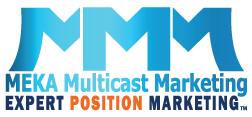Lead Source Tracking…Why it’s Integral to Your Business Success
Imagine this scenario: You get in your car. You start up the engine. You put the car in reverse. You look straight forward. And you slam on the gas.
It wouldn’t take very long for you to be in a state of total destruction.
You’d never do this in a car (hopefully). Yet, this is how most small businesses operate when it comes to how they track their advertising spend.
I would argue that behind automated follow up, lead source tracking is the most beneficial feature of MEKA Multicast Marketing. We can track all customer purchases historically, and attach that revenue to the lead source, you have a full view of the ROI of your advertising dollars instead of just the myopic view you get through advertising platforms such as Google or Facebook.
Having managed millions of dollars of ad spend, I can honestly say that tracking lead sources correctly is the single most important thing you can be doing when spending money to grow your business.
What’s Lead SourceTracking All About?
So, first let’s back up and get on the same page.
When we talk about “lead source”, what we’re referring to is “where the lead came from”. Specifically you’d like to know exactly where they came from (i.e. which ad, from which campaign, from which platform).
If you know how much you spend on an ad, and you know exactly how many leads you got from that ad and how much revenue was generated by those people, then you can start to measure ROI of your ad spend.
It’s also important to understand that lead source is the first source. So, if a contact first found you from a Google search, then, later, came to your site from a Facebook re-targeting ad, the lead source would be Google.
And, it’s important to understand that the lead source is not “what” the contact did. Often people code lead sources as “Free Report” or “Consult Request”. Those things tell us what they did, not where they came from.
Why Is Tracking Lead Sources Important?
When you’re trying to grow your business, there is one fundamentally important question you should be asking yourself:
Where can I find more profitable customers?
Profitable is the key word there. We can find customers all over the place. But, when you look into your costs, you’ll realize that the cost of one customer is not the equal to the cost of another. Some sources provide customers at a much more cost effective rate than others.
So, when you’re spending time, money, or effort to find more customers, it would be wise to focus your resources where your return on investment and your profits are highest. And it would be wise to stop doing things that have a negative return on investment and redirect those funds towards things that have a positive return on investment.
In the course of my 35 years as a marketing consultant, I’ve helped some clients go from generating 300 leads each month to over 25,000 leads each month.
When people ask how we did it, my answer sounds silly, but is extremely powerful: We stopped doing things that didn’t work and we kept doing things that did work.
The only way we knew what was working and what wasn’t working was because we tracked lead sources correctly.
If you only track your cost per click, or cost per lead, or even cost per customer (as you can do in advertising platforms such as Facebook and Google), then you’ll often miss the boat and potentially make the wrong call.
Imagine this scenario:

Google gets me a LOT more leads, at a far cheaper cost, therefore I’ll spend more on Google. Maybe even cancel my Facebook advertising and allocate those funds towards Google because the Facebook leads cost me 5 times as much.Given this data. We would all tend to make some assumptions and therefore some decisions:
But this doesn’t tell the whole story.
Because with this limited data you don’t know anything about conversion.
So, let’s take a look now:

Although the traffic/leads from Facebook were more expensive, those leads seemed to be more qualified and converted to customers at a higher rate. Which, in the end, produced customers at less cost.Now all of a sudden, we realize that the assumptions we made would have caused us to make a poor decision.
See how knowing and understanding all the data can really help with decision making?
The problem is, we’re still not done. We’re still making decisions based on incomplete data.
Let’s take it one step further.
What we thought we knew initially was wrong. Ok, so now it’s getting interesting, right?
But then what we though we knew with further data was wrong also.
And now we’re back to our initial decision. But for completely different reasons.
Although Facebook produced more customers at a cheaper cost, those customers didn’t buy as much as the Google customers. The Google customers spent a lot more and we ended up with a positive ROI on our ad spend.
Now we’re finally making wise decisions based on complete data.
This is the beauty of lead source tracking in a system like Infusionsoft where all the data you need can come together to give you the whole picture. Infusionsoft the CRM and marketing automation platform that we recommend to all our clients.
Questions?
If you have any questions don’t hesitate to contact us. This is one of the most important things you should master in your business. As you do, your success and business growth through marketing will open up to you in an amazing way.

